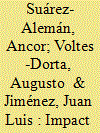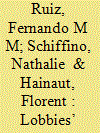| Srl | Item |
| 1 |
ID:
147497


|
|
|
|
|
| Summary/Abstract |
The rising trend in income inequality has recently attracted a renewed interest in the determinants of this growing trend across many countries. This article adds to the debate by investigating the impact of defence expenditure as a possible determinant of inequality in Taiwan, a country once was considered to be a poster child of an equitable growth, but now income inequality has become one of the Taiwan’s growing challenges. Applying the bounds test approach to cointegration and four long-run estimators for the period from 1976–2011, we found a long-run relationship between the various measures of inequality and defence expenditure where defence expenditure exerts a positive and a statistically significant impact on the worse income inequality in Taiwan. Further application of the lag-augmented causality test procedure also reveals a unidirectional causality running from defence expenditure to income inequality with defence expenditure causing income inequality to rise.
|
|
|
|
|
|
|
|
|
|
|
|
|
|
|
|
| 2 |
ID:
147491


|
|
|
|
|
| Summary/Abstract |
Controversy has long surrounded the role and profitability of US defense contractors. From a financial perspective the question becomes whether defense contractors earn greater profits and investor returns than other companies during military conflicts. We explore this question by examining the accounting profitability and investor returns of US aircraft manufacturers before, during, and after World War II and compare them to a sample of non-defense firms. We also examine the reactions of aircraft stock prices to important political and military events of the time. We find that (1) aircraft stocks exhibited positive abnormal returns around events associated with defense buildups and outbreaks of hostile action and negative returns around events signaling an end to hostilities, (2) the company’s accounting returns improved during the war but these higher accounting returns did not translate into higher stock returns for the shareholders, and (3) investors could have earned higher stock returns had they switched out of aircraft stocks after Pearl Harbor and reinvested the proceeds in the overall market.
|
|
|
|
|
|
|
|
|
|
|
|
|
|
|
|
| 3 |
ID:
147496


|
|
|
|
|
| Summary/Abstract |
In late 2011, the Spanish terrorist organization ETA announced the end of armed violence after more than forty years of illegal activity. While the existing literature has already established the negative impact of terrorist actions on international tourism in a particular region, this paper aims to determine whether ETA’s final ceasefire and definitive dissolution had a positive impact on domestic tourism in Basque Country. To that end, a directed gravity model is estimated over a panel data-set of 699 domestic tourist flows between the Spanish regions from 2008 to 2013. Results suggest that the negative impact on visitor flows was localized in the Basque Country. Also, regardless of a permanent ceasefire announced in 2010, only the 2011 ‘definitive cessation of violence’ had an immediate significant impact on the number of visitors to the Basque Country. These results complement the scarce literature on post-conflict tourism analysis and may have implications for regional authorities in affected regions in their efforts to rebuild their destination brands.
|
|
|
|
|
|
|
|
|
|
|
|
|
|
|
|
| 4 |
ID:
147492


|
|
|
|
|
| Summary/Abstract |
Lobbyists may not share the same interests, but they usually agree to form a link in a network which could eventually be used to spread information, to search for potential partners, to speak with one voice to decision makers. In other words, social links represent value for lobbyists because they may ultimately facilitate access. In this article, we explore the network of the Security and Defense lobbies in the EU and we describe its structure.
|
|
|
|
|
|
|
|
|
|
|
|
|
|
|
|
| 5 |
ID:
147494


|
|
|
|
|
| Summary/Abstract |
As the most knowledge-intensive industrial sectors, China’s defense industries are developing very fast. The present paper will explore the contribution of China’s defense innovation to its economic growth. Cobb–Douglas production function, integrating defense and non-defense stock in knowledge, is applied during the course. In addition, an input–output analysis of defense equipment procurement was done. Positive effect of China’s defense innovation on economic growth has been revealed by comparing the results from the two methods. And some suggestions are made to strengthen the effect.
|
|
|
|
|
|
|
|
|
|
|
|
|
|
|
|
| 6 |
ID:
147493


|
|
|
|
|
| Summary/Abstract |
There is often a call in any organization to make the system ‘more efficient’. This document describes a novel framework for measuring organizational efficiency at the microeconomic level. We show how this framework can be used to monitor an organization using data typically available in extant performance management frameworks. This is most useful in large organizations with eclectic outputs where resources may be too constrained to perform industry-level analyses, such as data envelope analysis, to infer efficiency. This method helps illuminate how the factors of an organization’s internal practices can affect its efficient use of resources.
|
|
|
|
|
|
|
|
|
|
|
|
|
|
|
|
| 7 |
ID:
147495


|
|
|
|
|
| Summary/Abstract |
This paper analyses the statistical distribution of war sizes. Using a new methodology we find moderate support for a Pareto-type distribution (power law), considering data from different sources (COW and UCDP) and periods. A power law is a plausible model for the size distribution of a pool of all wars and a sample of wars in many years, although the log-normal distribution is a plausible alternative model that we cannot reject. The random growth of conflicts could generate both types of distribution. We study the growth rates of battle deaths and random growth cannot be rejected for most of the distribution, although the results also reveal a clear decreasing pattern; the growth of deaths declines faster if the number of initial deaths is greater.
|
|
|
|
|
|
|
|
|
|
|
|
|
|
|
|